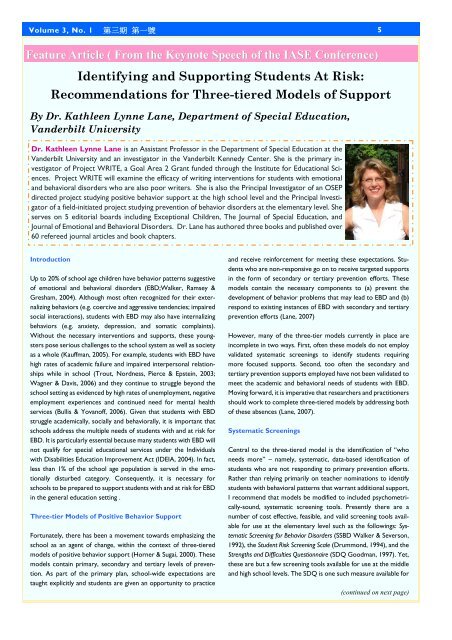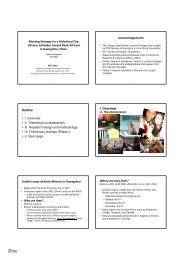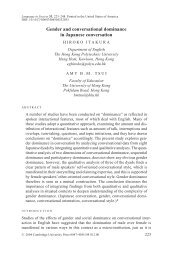Issue No.5 - Faculty of Education - The University of Hong Kong
Issue No.5 - Faculty of Education - The University of Hong Kong
Issue No.5 - Faculty of Education - The University of Hong Kong
Create successful ePaper yourself
Turn your PDF publications into a flip-book with our unique Google optimized e-Paper software.
Volume 3, No. 1 第三期 第一號 5<br />
Feature Article ( From the Keynote Speech <strong>of</strong> the IASE Conference)<br />
Identifying and Supporting Students At Risk:<br />
Recommendations for Three-tiered Models <strong>of</strong> Support<br />
By Dr. Kathleen Lynne Lane, Department <strong>of</strong> Special <strong>Education</strong>,<br />
Vanderbilt <strong>University</strong><br />
Dr. Kathleen Lynne Lane is an Assistant Pr<strong>of</strong>essor in the Department <strong>of</strong> Special <strong>Education</strong> at the<br />
Vanderbilt <strong>University</strong> and an investigator in the Vanderbilt Kennedy Center. She is the primary investigator<br />
<strong>of</strong> Project WRITE, a Goal Area 2 Grant funded through the Institute for <strong>Education</strong>al Sciences.<br />
Project WRITE will examine the efficacy <strong>of</strong> writing interventions for students with emotional<br />
and behavioral disorders who are also poor writers. She is also the Principal Investigator <strong>of</strong> an OSEP<br />
directed project studying positive behavior support at the high school level and the Principal Investigator<br />
<strong>of</strong> a field-initiated project studying prevention <strong>of</strong> behavior disorders at the elementary level. She<br />
serves on 5 editorial boards including Exceptional Children, <strong>The</strong> Journal <strong>of</strong> Special <strong>Education</strong>, and<br />
Journal <strong>of</strong> Emotional and Behavioral Disorders. Dr. Lane has authored three books and published over<br />
60 refereed journal articles and book chapters.<br />
Introduction<br />
Up to 20% <strong>of</strong> school age children have behavior patterns suggestive<br />
<strong>of</strong> emotional and behavioral disorders (EBD;Walker, Ramsey &<br />
Gresham, 2004). Although most <strong>of</strong>ten recognized for their externalizing<br />
behaviors (e.g. coercive and aggressive tendencies; impaired<br />
social interactions), students with EBD may also have internalizing<br />
behaviors (e.g. anxiety, depression, and somatic complaints).<br />
Without the necessary interventions and supports, these youngsters<br />
pose serious challenges to the school system as well as society<br />
as a whole (Kauffman, 2005). For example, students with EBD have<br />
high rates <strong>of</strong> academic failure and impaired interpersonal relationships<br />
while in school (Trout, Nordness, Pierce & Epstein, 2003;<br />
Wagner & Davis, 2006) and they continue to struggle beyond the<br />
school setting as evidenced by high rates <strong>of</strong> unemployment, negative<br />
employment experiences and continued need for mental health<br />
services (Bullis & Yovan<strong>of</strong>f, 2006). Given that students with EBD<br />
struggle academically, socially and behaviorally, it is important that<br />
schools address the multiple needs <strong>of</strong> students with and at risk for<br />
EBD. It is particularly essential because many students with EBD will<br />
not qualify for special educational services under the Individuals<br />
with Disabilities <strong>Education</strong> Improvement Act (IDEIA, 2004). In fact,<br />
less than 1% <strong>of</strong> the school age population is served in the emotionally<br />
disturbed category. Consequently, it is necessary for<br />
schools to be prepared to support students with and at risk for EBD<br />
in the general education setting .<br />
Three-tier Models <strong>of</strong> Positive Behavior Support<br />
Fortunately, there has been a movement towards emphasizing the<br />
school as an agent <strong>of</strong> change, within the context <strong>of</strong> three-tiered<br />
models <strong>of</strong> positive behavior support (Horner & Sugai, 2000). <strong>The</strong>se<br />
models contain primary, secondary and tertiary levels <strong>of</strong> prevention.<br />
As part <strong>of</strong> the primary plan, school-wide expectations are<br />
taught explicitly and students are given an opportunity to practice<br />
and receive reinforcement for meeting these expectations. Students<br />
who are non-responsive go on to receive targeted supports<br />
in the form <strong>of</strong> secondary or tertiary prevention efforts. <strong>The</strong>se<br />
models contain the necessary components to (a) prevent the<br />
development <strong>of</strong> behavior problems that may lead to EBD and (b)<br />
respond to existing instances <strong>of</strong> EBD with secondary and tertiary<br />
prevention efforts (Lane, 2007)<br />
However, many <strong>of</strong> the three-tier models currently in place are<br />
incomplete in two ways. First, <strong>of</strong>ten these models do not employ<br />
validated systematic screenings to identify students requiring<br />
more focused supports. Second, too <strong>of</strong>ten the secondary and<br />
tertiary prevention supports employed have not been validated to<br />
meet the academic and behavioral needs <strong>of</strong> students with EBD.<br />
Moving forward, it is imperative that researchers and practitioners<br />
should work to complete three-tiered models by addressing both<br />
<strong>of</strong> these absences (Lane, 2007).<br />
Systematic Screenings<br />
Central to the three-tiered model is the identification <strong>of</strong> “who<br />
needs more” – namely, systematic, data-based identification <strong>of</strong><br />
students who are not responding to primary prevention efforts.<br />
Rather than relying primarily on teacher nominations to identify<br />
students with behavioral patterns that warrant additional support,<br />
I recommend that models be modified to included psychometrically-sound,<br />
systematic screening tools. Presently there are a<br />
number <strong>of</strong> cost effective, feasible, and valid screening tools available<br />
for use at the elementary level such as the followings: Systematic<br />
Screening for Behavior Disorders (SSBD Walker & Severson,<br />
1992), the Student Risk Screening Scale (Drummond, 1994), and the<br />
Strengths and Difficulties Questionnaire (SDQ Goodman, 1997). Yet,<br />
these are but a few screening tools available for use at the middle<br />
and high school levels. <strong>The</strong> SDQ is one such measure available for<br />
(continued on next page)
















